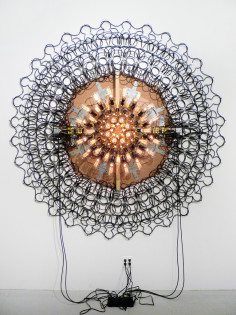ALBERTO TADIELLO
taraxacum

source: triangulationblog
Alberto Tadiello’s works explore the possible forms of autonomous function associated with different objects and mechanisms as they undergo a parossistic conceptualization of their own functional logic. This logic is altered and tampered in order to start reflecting upon those deeper and psychological aspects which connect people to things and technologies. An EPROM (Erasable Programmable Read-Only Memory) is a type of computer memory chip that can be erased and re-programmed variously, but for a limited amount of times. Following the form and function of the EPROM, Tadiello’s installation is based on a number of traditional music boxes directly fixed on the wall, activated by electric motors and each one connected to a transformer. Moved quickly by the mechanisms, the small cylinders reach a high-speed rotation, which they usually can’t stand up to, unavoidably wearing them out. As a result the fairy-like sound and the rhythm overturn and change into an unpleasant excess. Once the pawls wear out the noise slowly becomes less noticeable and even indistinguishable. The high-speed movement is associated with a sort of cathartic event, which relieves the music box interface from bearing nostalgic feelings.
.
.
.
.
.
.
.
.
source: fastcodesign
Alberto Tadiello is a bit of an enigma. “I don’t have a design background–not at all,” he tells Co.Design. “I have a background as a mountain climber and as a construction worker.” Despite the subtle subterfuge surrounding his creative pedigree, he has spent the last decade building up an impressive body of work, including numerous intricate solo and group exhibitions, residencies, and awards. understanding of his particular site-specific installations. “I’m interested in creating a physical experience without implicating a physical contact,” he says. “What I want is to make something epidermic that borders visual and auditory sensations, becoming nearly tactile.”
As such, many of his pieces–composed of electrical equipment arranged in entirely new standalone and wall-bound constructions–feature a sonic element; this added aural pleasure transforms the often purely visual gallery visit into something extrasensory. “Rather than working with sound, I believe I’m working with sonorities, timbres, pitches,” he says. “I always refer myself to elements like resonance, vibration, and echo and to the possibility of sound to draw and sculpt a space.” inspiration strikes. “There are works that start with notes, researches, abstract ideas, concepts, and so on, and I go searching for the ‘suitable materials’ only later, consequently. Sometimes everything works exactly the other way around. I find the materials, and then I make a project turn around them, developing a concept.”
While this fluid approach seems like it might be at odds with the incredibly precise nature of some of his more complex endeavors, there is a beautiful poetry that is inherent within the final results and his intentions. “What I would really like is that when people leave an exhibition space, they could bring along the residue of what they saw, heard, and felt. I think that would be enough,” he says. “I believe something similar occurs when you face the sun–when you turn your face completely to the sunlight. Once you close your eyes, the spots of what impressed them remain in the head. On the face a sort of warmth burns.”
.
.
.
.
.
.
.
.
source: beautifuldecay
The work of Italian artist Alberto Tadiello peeks into the vagaries of technology, nature, and their relationships. For example, the first five photos of this post depict the installation EPROM (an acronym for Erasable Programmable Read Only Memory). The installation mounted on the wall consists of music boxes connected to small electric motors, which are in turn connected to transformers. While the tinny notes of the music boxes may conjure memories of childhood at first, the motors and music boxes are soon spinning faster than the mechanisms can withstand. Eventually the motors wear out reducing the ‘music’ to a hardly noticeable noise. Of this event, the gallery statement says:
“Once the pawls wear out the noise slowly becomes less noticeable and even indistinguishable. The high-speed movement is associated with a sort of cathartic event, which relieves the music box interface from bearing nostalgic feelings.”
.
.
.
.
.
.
.
.
.
source: blogarscite
Los conceptos de tiempo y espacio son relativos, lo cual les convierte en terreno perfecto para todo tipo de experimentos, incluyendo experimentos y fantasías artísticas como las utópicas máquinas del italiano Alberto Tadiello, un joven artista que a través de instalaciones medioambientales, esculturas y dibujos analiza las relaciones que existen entre las señales visuales y acústicas.
Sus criaturas de ingeniería poética cobran vida en una especie de continúa funcionalidad disfuncional, reflejando así las paradojas y comportamientos del ser humano. La obra de Tadiello tiene un potente componente visual que se debe a composiciones limpias y geométricas, pero sin lugar a dudas su obra es el tipo de arte hecho para ser experimentado en persona. Por lo tanto, si estás interesado aún quedan unos pocos días para visitar su gran exposición individual High Gospel en el Museo di Arte Contemporanea di Villa Croce en Génova (Italia), abierta hasta el 18 de febrero. High Gospel ofrece una visión general de la obra del artista, y en particular, de su nueva serie de site-specific art – instalaciones sonoras, esculturas de gran formato, dibujos, mecanismos varios encerrados en su propia obsolescencia – creando así un discurso que contrasta con las clásicas salas del museo.

